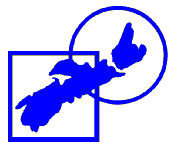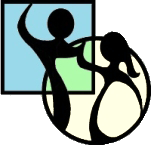

Square and Round Dance Federation
of Nova Scotia
SQUARE DANCING IN NOVA SCOTIA
by Elmer F. Caborn about 1990
Interviews with oldsters assure us that some form of Square Dancing in Nova Scotia goes back at least into the teens in this century and probably further than that. It may have been more popular in rural areas then it was in urban areas, possibly because urban areas may have had other forms of entertainment. It also appears that Cape Bretoners may have pursued this activity more vigorously than the rest of the province. We know there was Square Dancing at Londonderry near Truro in the late teens and tweenties and one caller was Matt McElman. Also there was Square Dancing in the thirties in New Waterford. A club was formed there known as the Hiburnia and one of the callers was Danny Dewan. We know there was Square Dancing in Cape Breton in the forties where one of the callers was Mr. MacEachern (Pat Alguire's father).
It seems that the moves used varied from place to place in the province. Mildred Carmichael remembers dancing where each square had its own caller, who also danced. With three squares in the hall, each square would be doing something different. However, this seemed to be the exception. Most dancers I talked to remember one caller for the hall. In Cumberland County, for example, the dancers usually set up in a circle which quickly became a rectangle so that there were several side couples and several head couples. The exact number wasn't important. (I'm not sure of the nomenclature here -- they may have been called end and side couples.) They would do Forward and Back then Forward and Pass Through. They also did Allemande Left and Grand Right and Left. Sometimes the caller would tell them to Swing each time they met a new person. This ensured that by the time they got back to their own partner they would be ready to rest. It should be emphasized that these dances were not exclusively square dances. They also danced waltzes, two-steps, polkias, schottisches and other local variations. BACK
FMost of the time, the music for these dances was provided by a single violin. At other times someone would help the fiddler out with chords on a piano or guitar. Where more volume was needed as in a large hall, they might have two or more violins. Occasionally the music was provided by an accordion and, more rarely, by a mouth organ.
Up until the fifties, it seems there was little or no liaison between Square Dance groups with each group having their own moves so that visiting between groups was limited. There were, however, a few standard moves which most groups used. These were: Allemande Left or Right, Grand Right and Left, Doh-sah-doh, Promenade, and probably some others. There were no such thing as classes, one simply watched for a while and then got up and danced. BACK
This picture began to change in the fifties when several clubs formed in the Halifax-Dartmouth area and visiting between clubs became common. Some of these clubs were the Maurianna Whirlers with Maurice Hennigar, The Merry Millers with Vern Carmichael, The Happy Whirlers with Horace Williams, Ron Duffy and Graham Geddes, The Harbor Hoppers with Dave and June Hunter and the Gralorne Squares with Graham Geddes and Lorne Tyler. The only club which was formed in the fifties outside of the Halifax-Dartmouth area that we know of was the Jolly Rogers Squares of Milton with Roger Whynot, Arch Erickson, Ivan Dogget and John Medicraft as callers over the years.
Through the fifties and into the sixties, the type of Square Dancing performed was known as the old or traditional type including the the Lancers, Quadrilles and Contras. One common move was Birdie-in-the-Cage. Contra Dancing was very popular in New England, so it is very probable that it may have spread form New England into the Maritimes. Vern Carmichael, in particular, was fond of Contra Dancing. BACK
In the early sixties an event was taking place in far-off California that would forever change Square Dancing, not only in Nova Scotia, but in all the world. Three callers, namely, Bob Osgood, Stan Burdick and Charlie Baldwin, organized CALLERLAB and set out to standardize Square Dance moves. They spread the word through the three Square Dance Magazines which were "Square Dancing", "American Square Dance" and "New England Square Dance Caller". As you can imagine, there was some resistance and many of the old-time callers carried on the traditional type for some time. But, by the early seventies most clubs had converted to what is known as Modern Square Dancing.
In the seventies, another type of dancing became closely associated with Square Dancing. It is known as cued Round Dancing and soon became quite popular. Several Round Dance clubs were organized in the late sixties and early seventies. The first of these was Dancing Shadows in Dartmouth with John and Fran Essex and Tom and Marg Keighan. Also, about the same time the Min-u-ettes in Stellarton with Brundage MacDonald and Marje Johnstone was organized. Round Dancing has now become an integral part of Squre Dancing and most Square Dance clubs intersperse a few easy Rounds between Square Dance tips. BACK
We are indebted to two ladies who realized several years ago that there were little or no records kept of Square Dance Clubs in Nova Scotia. These two ladies decided to do something about this. They were Mildred Carmichael (wife of caller Vern) and Obee Benjamin (wife of dancer Fred). They must have spent many hours and written dozens of letters to get the information, but they did it. They completed their research by drawing up charts which show when each club started. the callers names and also the date the club was dissolved, if applicable. This means we now have a permanent record of Nova Scotia Square Dance Clubs since 1950. BACK